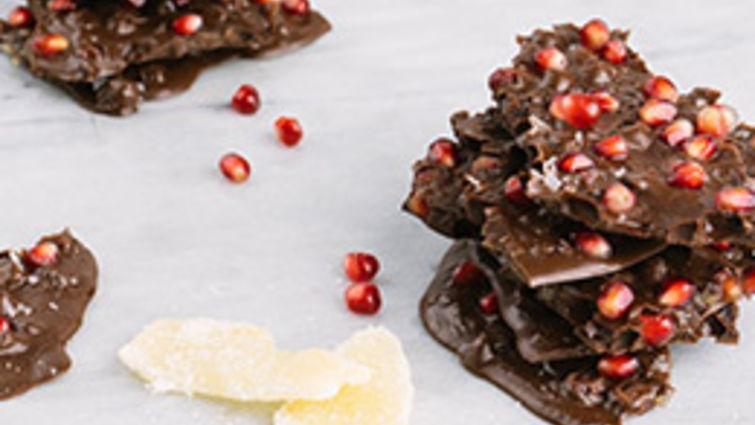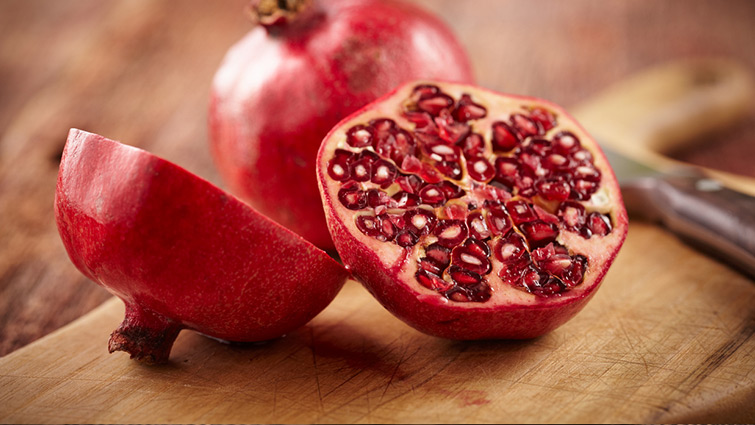Available in English, Spanish, French, Chinese, and Portuguese.
#liveitlomalinda
Is there a way to make dark chocolate even more delicious and beneficial for your health? Yes! Add antioxidant-packed ginger and pomegranate seeds, and you’ve got a delicious, mood-boosting treat with no guilt. Now, doesn’t that put a smile on your face?

Recipe: Dark Chocolate Pomegranate Bark
Serving size: 10
Servings per recipe: 2 pieces
Prep time: 20 min
- 10 oz. - Dark chocolate, 70-85% cacao or more
- 1 cup - Pomegranate seeds, fresh
- 1.5 Tbsp - Candied ginger, minced
- 1/4 Tbsp - Cayenne pepper, ground
- 1/4 tsp - Kosher salt
Directions
De-seed the pomegranate. Make sure to discard the pithy white pieces that stick to the seeds.
In a separate bowl, combine half of the pomegranate seeds and candied ginger, then sprinkle cayenne pepper evenly on top. Mix thoroughly to ensure the cayenne pepper is evenly distributed.
Fit a heatproof bowl over a pot of low simmering water. Place the chocolate in the bowl and stir until fully melted, about 5 minutes. Remove the bowl from the pot and stir the pomegranate and ginger mixture into the melted chocolate.
Place parchment paper on a baking sheet. Pour melted chocolate mixture onto the sheet using a spatula to smooth the chocolate into one even layer about 1/4 inch thick. Sprinkle chocolate with remaining pomegranate seeds while lightly pressing them into the chocolate and top with kosher salt.
Let sit out until the chocolate hardens. Break into pieces and enjoy!
Nutrition Facts
Serving size:
| Calories | 167 |
| Carbohydrates | 21g |
| Fiber | 3g |
| Total Fat | 10g |
| Saturated Fat | 6g |
| Monounsaturated Fat | 3g |
| Sodium | 65g |
| Total Carbohydrate | 21g |
| Dietary Fiber | 3g |
| Protein | 2g |
| Sugar | 16g |

Star Ingredient:
Pomegranates Contain:
Vitamin K*
Vitamin K has long been known for its role in blood clotting. It also participates in the synthesis of several bone proteins. Bacteria in the intestinal track synthesize vitamin K that the body can absorb but people cannot depend on this source alone for vitamin K. Many foods contain ample amounts of vitamin K, notably green leafy vegetables and members of the cabbage family. If you are taking blood-thinning medication, be sure to talk with your Registered Dietitian or Physician about how much vitamin K is safe for you to consume.
Vitamin C*
Did you know the human body does not have the ability to produce vitamin C on its own? That’s why it’s so important to make sure we are eating a wide variety of foods with Vitamin C. This vital vitamin is not only useful to help our bodies fight off the common cold, but it’s necessary for the absorption of iron and very important for our connective tissues. Connective tissues are what keep our skin firm and our muscles strong. Because vitamin C supports our connective tissues, it is also useful in speeding up the healing process. If you have a wound, you might want to consider increasing the intake of foods higher in vitamin C.
Trivia: Cats and dogs can make vitamin C therefore they don’t need fruits and vegetables.
Folate*
Did you know folate is part of the B-vitamin family, otherwise known as vitamin B9? It is active in cell division. During periods of active growth and cell division, such as pregnancy and adolescence, folate needs to increase, and deficiency is especially likely. The best food sources of folate are liver, legumes, green leafy vegetables, and beets. Among the fruits, they are oranges, orange juice, and cantaloupe. Heat and oxidation during cooking and storage can destroy up to half the folate in foods.
*These statements have not been evaluated by the Food and Drug Administration. This is not intended to diagnose, treat, cure, or prevent any disease.









